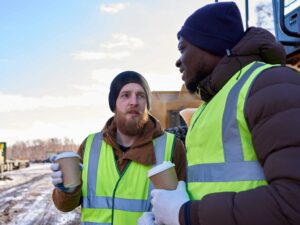
Asbestos: Hidden Health Risk in the Workplace
In today’s fast-paced world, workplace safety has rightfully taken centre stage as a critical concern for employers and employees alike. While many dangers are readily visible, some remain hidden from plain sight, posing potential risks that can have far-reaching consequences. One such hidden health risk is asbestos – a seemingly innocuous material that has the potential to wreak havoc on the health of those exposed to it in the workplace.
Unveiling the Health Risk
Asbestos is a group of naturally occurring minerals that were once heralded for their versatility and durability. They found their way into various industries due to their resistance to heat, fire, and corrosion. However, the same properties that made asbestos desirable also make it deadly when its fibres are released into the air and subsequently inhaled.
Prolonged exposure to asbestos fibres can lead to severe health issues, including lung diseases like asbestosis, lung cancer, and a particularly aggressive cancer known as mesothelioma. These diseases often have long latency periods, with symptoms appearing years or even decades after the initial exposure.
This makes it essential to address asbestos hazards promptly to prevent potential harm to employees.
Identifying Asbestos-Containing Materials
Identifying asbestos-containing materials (ACMs) can be challenging, as they are often integrated into the structure of buildings, machinery, and various products. It’s impossible to determine whether a material contains asbestos just by looking at it.
Asbestos fibres are microscopic and can’t be identified with the naked eye. Therefore, proper testing by qualified professionals is necessary to confirm the presence of asbestos.
Common materials that might contain asbestos include ceiling tiles, insulation, roofing materials, flooring, and even textured coatings. If your workplace was constructed before the 1980s, there’s a higher likelihood of encountering asbestos-containing materials, as its use was prevalent in construction during that time.
The Importance of Asbestos Removal and Disposal
Given the severe health risks associated with asbestos exposure, it’s crucial to remove and properly dispose of ACMs in a safe and controlled manner. Attempting to remove asbestos without proper training and equipment can result in the release of airborne fibres, further exacerbating the hazard.
Asbestos removal involves careful planning, containment of the work area, specialized equipment, and adherence to strict safety protocols. Once removed, asbestos waste must be disposed of in accordance with local regulations to prevent environmental contamination and potential exposure to others.
Apex Environmental: Your Partner in Asbestos and Health Risk Management
Asbestos may be a hidden danger, but with Apex Environmental on your side, it doesn’t have to remain a threat. Visit our website to explore our comprehensive offerings and take the first step towards a safer, asbestos-free workplace. Let’s work together to unveil a future where the health and well-being of your employees are safeguarded from the shadows of asbestos.








